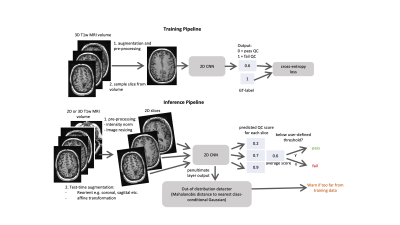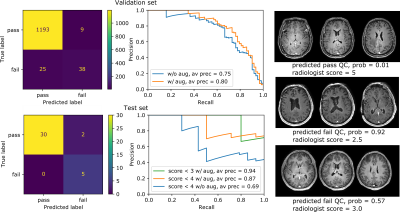Ben A Duffy1, Srivathsa Pasumarthi Venkata1, Long Wang1, Sara Dupont1, Lei Xiang1, Greg Zaharchuk1, and Tao Zhang1
1Subtle Medical Inc., Menlo Park, CA, United States
1Subtle Medical Inc., Menlo Park, CA, United States
We
present a deep learning-based quality control system that generalizes to images
from different sites, different orientations and images with and without contrast.
Performance is enhanced using test-time augmentation. Robustness is ensured
using out-of-distribution detection.

Figure 1: Training and Inference pipelines: 2D CNN predicts the probably of QC failure
for each 2D slice. At inference time, the mean QC score for each slice is used
for the volume-wise prediction. In addition, reorientations and affine
transformations are used as test-time augmentations. Robustness can be ensured
by outputting the penultimate layer from the 2D CNN and comparing it to the
nearest class-conditional Gaussian distribution of the training data.

Figure 4: Performance evaluation for both the validation and test sets. From left to right:
confusion matrices, precision recall curves, example test-set images with QC
predictions and average radiologist scores. Performance improvements using
test-time augmentation are shown in the precision recall curves as an increase
in average precision from 0.75 to 0.8 (validation set) and 0.69 to 0.87 (test
set) (abbreviations: w/o aug - without test-time augmentation, w/ aug = with
test-time augmentation).